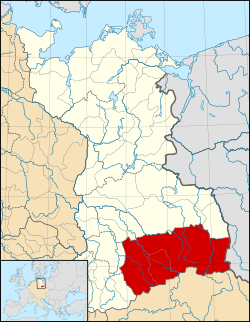Margravate of Meissen Markgrafschaft Meißen (German) | |||||||||
|---|---|---|---|---|---|---|---|---|---|
| 965–1423 | |||||||||
 March of Meissen (red) in the early 11th century | |||||||||
| Status | Margravate | ||||||||
| Capital | Meissen | ||||||||
| Common languages | Upper Saxon | ||||||||
| Government | Feudal monarchy | ||||||||
| Margrave of Meissen | |||||||||
• 965–976 | Wigbert (first) | ||||||||
• 1381–1423 | Frederick IV | ||||||||
| Historical era | Middle Ages | ||||||||
• Partitioned from Marca Geronis | 965 | ||||||||
• Captured by Poland | 1002 | ||||||||
| 1067 | |||||||||
• War of Thuringian Succession | 1247–64 | ||||||||
• Acquired most of Thuringia | 1298 | ||||||||
| 1307 | |||||||||
• Frederick IV assigned Saxe-Wittenberg | 1423 | ||||||||
• Acquired Burggravate | 1426 | ||||||||
| |||||||||
| Today part of | Germany Poland | ||||||||
1: As a result of the Investiture Controversy in 1067, the territory was lost from the Brunonen to the Wettin dynasty. | |||||||||
The Margravate or Margraviate of Meissen (German: Markgrafschaft Meißen) was a medieval principality in the area of the modern German state of Saxony. It originally was a frontier march of the Holy Roman Empire, created out of the vast Marca Geronis (Saxon Eastern March) in 965. Under the rule of the Wettin dynasty, the margravate finally merged with the former Duchy of Saxe-Wittenberg into the Saxon Electorate by 1423.
- ^ "flaggenlexikon.de: Flaggen für Markgrafschaft Meißen" (in German). Archived from the original on 2021-06-14. Retrieved 2021-06-14.


